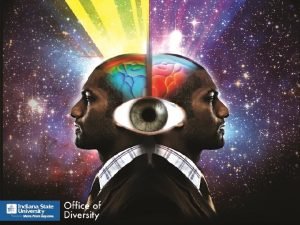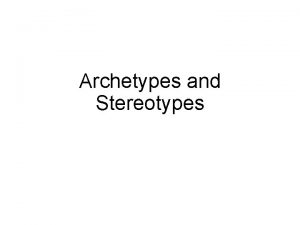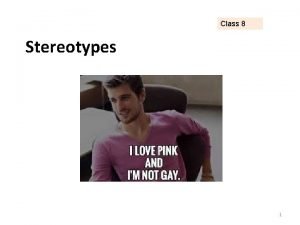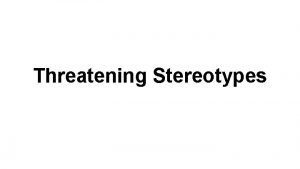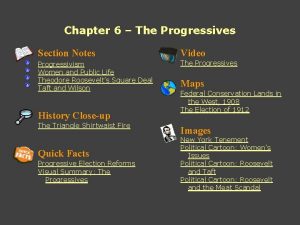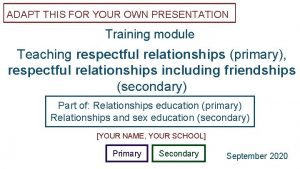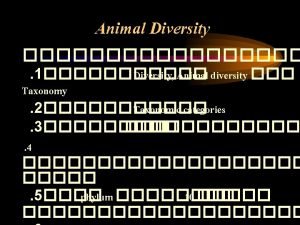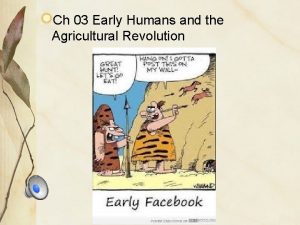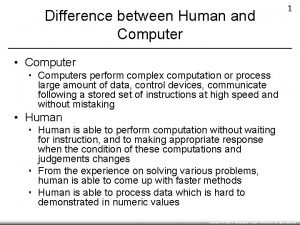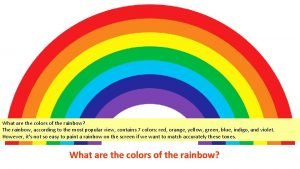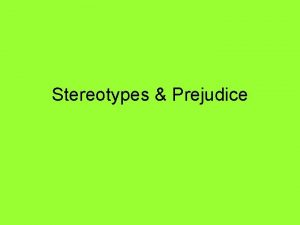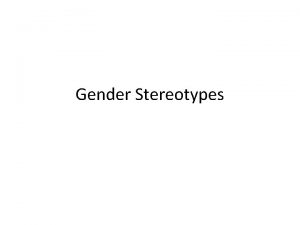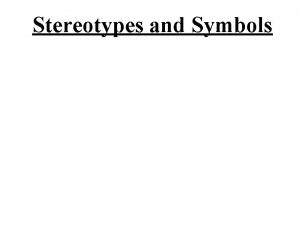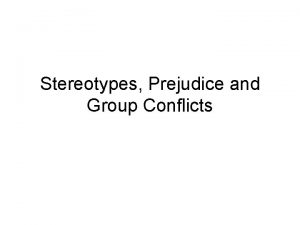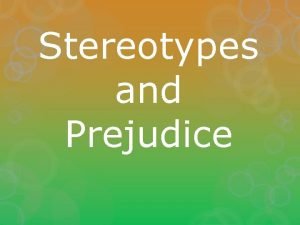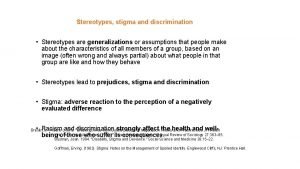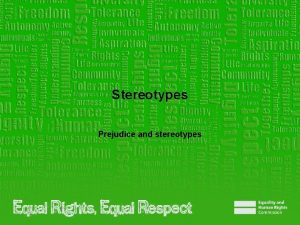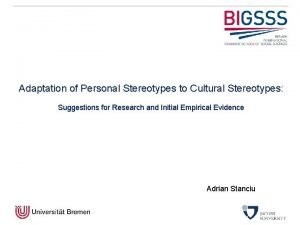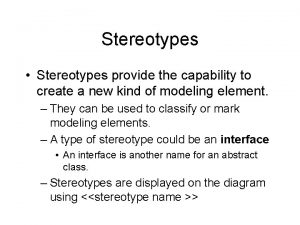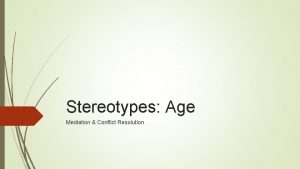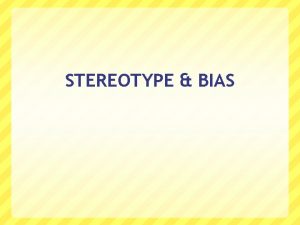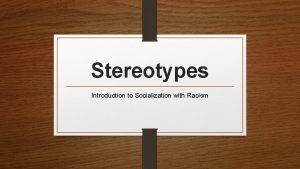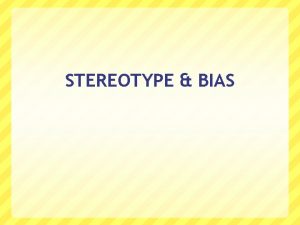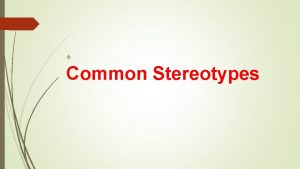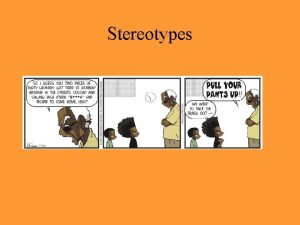Stereotypes HUMANS AND CATEGORIES Stereotypes Official definition of














































- Slides: 46

Stereotypes HUMANS AND CATEGORIES

Stereotypes Official definition of a stereotype: �“a fixed mental image of a group that is frequently applied to all its members. ” �The world is complex and confusing. �We confront it by finding ways to categorize, compartmentalize, and define.

Stereotypes Teachers use categories to help explain complex concepts. �For example, “There are four main categories of advertising. �Or “There are three basic philosophies of modern media ethics. ”

Stereotypes �Researchers use categories to help define and label. �If you label something, it helps you to understand it. �For example, we can categorize millions of biological species by an extensive system of botanical classes: Kingdom, Phylum, Class, Order, Family, Genus, Species.

Stereotypes �We also like to categorize human beings. Humans are complex, and so to categorize simplifies. �Most of our knowledge of the world comes from somebody else, and not our direct experience. �We can use this second-hand knowledge to build compartments.

Stereotypes �From those compartments, we can fit people into what we already think we know about the world—our preconceived notions. �Unfortunately, this stereotyping, while making the world simpler, also can lead to unfair treatment of others.

Stereotypes Obvious stereotypes: �Sexism. �Racism. �Ethical prejudice. �Religious prejudice. �These are most discussed, and most controversial.

Stereotypes But other groups also are stereotyped. In fact, most are. For example: �Fat people=slothful slobs. �Journalists=people without scruples. �Professors=absent-minded and out of touch. �Students=arrogant and lazy boozers. �Politicians=unethical and sleazy. �? Name your group.

Stereotypes �Many areas of the United States, and their people, are stereotyped through the media. �In fact, one of the most common American stereotypes: Fargo, North Dakota. [http: //www. youtube. com/watch? v=W 6 c 8 b. Yq 9 Ve 8]

Stereotypes �So we can relate to the result of geographic stereotyping in the media. �But we also stereotype other countries. �The U. S. media typically has unflattering portrayals of Russia, Arab or African countries. �Their media also stereotypes the United States negatively, of course.

Stereotypes �Stereotyping was rampant and even more accepted throughout history. �Aristotle, the “father of virtue ethics, ” defended slavery in the fourth century B. C. E. �He said slaves should be treated differently: it was nature’s intention to make the bodies of slaves more suitable for “servile labors. ”

Stereotypes �Often people will try to defend stereotypes by finding an authority who will agree with them. �Religious Americans in the nineteenth century often defended slavery by pointing to the Bible book of Genesis, 9: 25 -27. Noah, upset at his son Ham, who was supposedly black, responded by cursing Ham’s son Canaan and all his offspring to be slaves for all eternity. � Genesis 9: 25 -27: “’Cursed be Canaan! The lowest of slaves will he be to his brothers. ’ He also said, ‘Blessed be the Lord, the God of Shem! May Canaan be the slave of Shem. May God extend the territory of Japheth; may Japeth live in the tents of Shem and may Canaan be his slave. ’”

Stereotypes �But do we sometimes need stereotypes to simplify complex things? Maybe. �Walter Lippmann in 1922 defended some stereotyping.

Stereotypes �Lippmann observed that to see all things as new, fresh, and in detail, instead of types and generalities, is exhausting and time-consuming. �In modern life we don’t usually have time for this. �We rely, therefore, on generalities. As Lippmann noted:

Stereotypes �In our day-to-day interactions, “there is neither time nor opportunity for intimate acquaintance. Instead, we notice a trait which marks a well-known type, and fill in the rest of the picture by means of stereotypes we carry around in our heads. ” --Walter Lippmann

Stereotypes �Because we know little of the world by direct experience, we rely on others to tell us. �Especially we rely on mass media. �This seems to mean media people have an ethical responsibility to understand stereotyping versus reality.

Stereotypes �The patterns of stereotyping in ourselves are hardly neutral. �They involved personal perceptions of reality. �They also involve our emotions.

Stereotypes �Based on that, Lippmann noted we can use a stereotype to hide behind. �With the stereotype, we will feel safe in our position regarding another group or idea. �But stereotypes aren’t always bad.

Stereotypes �We can use stereotypes to group things, and so better study them, as we noted. �If you group people as students, or professors, or lawyers, or politicians, or farmers—this does contain some useful information for members of each category. �They will have traits in common—although each individual can’t be reduced to these aspects alone, but will have many more traits.

Stereotypes �Some may even have traits different from those suggested by the categories. �Nevertheless, we have to admit that stereotyping seems to work against the common belief of equality in society.

Stereotypes �Stereotypes can be unfair. �We don’t perceive individual differences, just groups. �If you believe people in society have the right to control of self, that is, self-determination— stereotyping takes that control away.

Stereotypes �Stereotypes put people in compartments they have no control over, merely because they are part of a certain group. �Putting all students, or North Dakotans, or professors, or blacks, or Muslims, into a category seems to undermine the belief in individual dignity and human worth. �Stereotypes are convenient. But they also create barriers.

Stereotypes �So are stereotypes lies? Not exactly. �Stereotypes do have a basis in reality. �The problem: making inaccurate judgments about another person based on the stereotype.

Stereotypes �For example, the media have traditionally pictured gay men as flamboyant and effeminate. �Some are. But these traits represent only a segment, not the whole group. �The image, however, helps to erect barriers between gays and the rest of society. Some critics argue such barriers are unethical.

Stereotypes �Which group has been most criticized for its use of stereotypes? The media. �The media need to avoid unfair stereotypes, while still emphasizing stereotypes may play legitimate roles, and may be inevitable. �Lippmann believed some stereotyping was necessary, and the media reflect this.

Stereotypes �Entertainment programs on television reflect stereotypes. �Television show formulas, or genres, produce stereotypical characters that an audience can relate to. �But the danger is that the TV stereotype will replace our critical judgment about people in real life.

Stereotypes �Three groups (to use categories) traditionally have been most identified as subject to media stereotypes: �Minorities. �Women. �Elderly.

Stereotypes �For literally generations, Americans thought of black people based on the media’s stereotypical image: slow-moving and dim-witted. �Surely this stereotype is no longer prevalent—is it? At least it seems to be gone from the media.

Stereotypes �More recent media stereotypes of African-Americans have depicted them as welfare recipients, drug pushers, impoverished, uneducated. �This fits one segment of the population. But it ignores the large segment of middle-class black people in America. �African-Americans in the media still are less often depicted in professional roles.

Stereotypes �Why do such stereotypes change so slowly in the media? �One factor: management of news media by minorities is not common. �Coverage of newsworthy social problems focus on those people most likely to represent the perceived stereotypes, such as the inner city black gang members or Hispanic illegal aliens.

Stereotypes �Native American stereotypes are significant in North Dakota and Minnesota, represented by a high Indian population. �In the past, Indians were portrayed by Hollywood as the “savages. ” �Long before that time, treating them as less than human in the press made it easier to brutalize and marginalize them as settlers expanded west.

Stereotypes �Stereotyping is first step toward ability to hurt or kill without guilt. It is always used during wartime: �The “Japs. ” �The “Krauts. ” �The “Gooks”

Stereotypes �The media reduced 400 Indian tribes in America to one stereotype of “brave and squaw” with “war bonnet or papoose. ” �But they began to complain in the 1970 s. Today media are working to overcome these obvious stereotypes.

Stereotypes �Advertisers also are criticized for stereotypes of Indians and others. �Advertising must rely on stereotypes, however: messages are short. �Advertisers regularly used stereotypical minorities to sell things, before minorities began to complain in the 70 s.

Stereotypes �Woman in particular have been stereotyped by advertisers and others. �In the 1950 s they were depicted an ads as wanting to please husbands and get cleaner laundry. [http: //www. youtube. com/watch? v=SOOlc. VAb. IEI&feature=related]

Stereotypes �Early television shows like “Leave It to Beaver” and “I Love Lucy” depicted stereotypical woman as either the “perfect wife” or “dumb and accident-prone. ” �These famous shows were entertaining to millions. But not very accurate depictions of women. �In 1970 s programming, women became more assertive and self-reliant, as in “Mary Tyler Moore” and “Golden Girls. ”

Stereotypes �Nevertheless, much advertising today still depicts women as obsessed with beauty, sex appeal, and interested mostly in being appealing to men. �This advertising does probably reflect a segment of that group. �But do advertisers and the media have some ethical responsibility to promote more positive images, or to simply reflect prevailing social norms?

Stereotypes We live in a youth-oriented culture. Negative portrayals of elderly people are common: �Infirm, stubborn, childlike, forgetful, crotchety and ridiculous. �The media do not seem to be altering their commonly distorted views of elderly, however, nor do they seem to face as much criticism of them.

Stereotypes �The disabled traditionally have been invisible in the media. �When they have been portrayed, it has been as helpless or pitiful. �Probably this is changing, but disabled people still face common stereotypes in the media.

Stereotypes �How do ethics philosophers consider stereotyping? �If they believe that the individual person must be respected, then stereotypes clearly undermine that respect. �Kant would ask us to make a decision universal. To universalize racism and prejudice by stereotype would probably not be considered acceptable to Kant.

Stereotypes �The Golden Mean might call for diversity in media presentations, not letting one segment represent the whole. �The teleologists would say the motive doesn’t matter, but results do. They might criticize someone like Norman Lear. Who is Norman Lear?

Stereotypes �Consider that deontologists like Kant would look at the motivation of the maker. �In the 1970 s Norman Lear created Archie Bunker, a white bigot that represented all the common prejudices of American culture. �He used stereotypes to confront the country’s racist attitudes. [http: //www. youtube. com/watch? v=O_UBgk. FHm 8 o]

Stereotypes �This was Lear’s motive—but some viewers did not recognize the satire, and so prejudice was reinforced and sanitized by television. �On the one hand, we as media professionals seem to have an ethical responsibility to avoid the really degrading and prejudicial stereotypes. �But what is degrading?

Stereotypes �On the other hand, society does have a cultural heritage. Many classic works contain stereotypical characters. �The stereotypes in Huckleberry Finn are racist. Should that book be banned? �But to ban that would really not reflect the freedoms of democracy.

Stereotypes �Perhaps instead of banning past stereotypes in shows like “I Love Lucy” or famous novels, we should instead work to overcome stereotypes in new work. �And we might consider stereotypes in other parts of our society. �For example, consider Halloween costumes. When we dress a child as a hobo, or Indian, or witch, are we perpetuating stereotypes?

Stereotypes �Can you think of a stereotype in your own life, or one from the media? Why was it used? Does it need to be used?
 Official compendia in pharmacy
Official compendia in pharmacy The stereotype of the predicate family
The stereotype of the predicate family Bias map
Bias map Archetypes and stereotypes
Archetypes and stereotypes Slovenia stereotypes
Slovenia stereotypes Panchatantra five principles
Panchatantra five principles Language stereotypes
Language stereotypes Stereotypes spielverhalten
Stereotypes spielverhalten Stereotypes in 12 angry men
Stereotypes in 12 angry men Hero stereotypes
Hero stereotypes Age stereotypes
Age stereotypes Czech republic stereotypes
Czech republic stereotypes Essential questions about stereotypes
Essential questions about stereotypes Activity 1 what do you know about stereotypes
Activity 1 what do you know about stereotypes Hamilton and gifford 1976 ib psychology
Hamilton and gifford 1976 ib psychology Goth who
Goth who Stereotype
Stereotype Kwl chart stereotypes
Kwl chart stereotypes Conforming to stereotypes
Conforming to stereotypes The canterbury tales prologue characters
The canterbury tales prologue characters New york stereotypes
New york stereotypes Gender stereotypes
Gender stereotypes New york stereotypes
New york stereotypes Sexual orientation stereotypes
Sexual orientation stereotypes Snopes
Snopes French people stereotypes
French people stereotypes Dutch stereotypes
Dutch stereotypes Research on the pros and cons of genetic engineering
Research on the pros and cons of genetic engineering What is the taxonomy of a domestic dog
What is the taxonomy of a domestic dog Biotechnology selective breeding
Biotechnology selective breeding Why is hair class evidence
Why is hair class evidence Early humans and the agricultural revolution
Early humans and the agricultural revolution Ffa official dress
Ffa official dress Privet shrubs and humans each have a diploid number of 46
Privet shrubs and humans each have a diploid number of 46 Privet shrubs and humans each have a diploid number of 46
Privet shrubs and humans each have a diploid number of 46 What is the relationship between humans and the environment
What is the relationship between humans and the environment Early humans and the agricultural revolution answer key
Early humans and the agricultural revolution answer key What is difference between human and computer?
What is difference between human and computer? Roles in your life
Roles in your life Routine request email example
Routine request email example Uil prose and poetry categories
Uil prose and poetry categories Trend vs fad
Trend vs fad Chapter 11 health vocabulary
Chapter 11 health vocabulary Business letter format parts
Business letter format parts R official website
R official website Indigo in rainbow
Indigo in rainbow How is water transported in humans
How is water transported in humans


